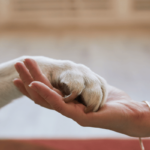Understanding adolescent dog care tips is crucial for navigating their teenage years. This phase brings unique challenges and milestones for both pets and owners.
Understanding Your Dog’s Adolescent Behavioral Changes

Adolescent dogs often exhibit noticeable behavioral changes. This period, akin to human teenage years, involves significant physical and psychological development. Owners might observe increased independence, sporadic obedience, and energy surges. Importantly, this phase requires patience and consistent training. Utilizing positive reinforcement techniques can be highly effective. Additionally, maintaining a routine helps in managing their unpredictable behavior, ensuring a smoother transition through this developmental stage.
During adolescence, dogs’ social skills evolve. They become more curious about their surroundings and other dogs. This curiosity, while natural, needs guidance. Socialization activities should be continued, but with careful monitoring. Introducing them to various environments, people, and other pets in a controlled manner enhances their adaptability. However, it’s crucial to recognize signs of discomfort or stress during these interactions, as forcing socialization can lead to negative experiences.
Physical care is also paramount in adolescent dog care. As they grow, their nutritional and exercise needs may change. Consulting a veterinarian for diet adjustments ensures their health is optimally supported. Regular exercise is vital for managing their increased energy levels. Activities like longer walks, playtime, and agility training not only expend energy but also strengthen the bond between owner and pet. Remember, a healthy lifestyle during adolescence sets the foundation for their adult life.
Effective Training Strategies for Adolescent Dogs
Training adolescent dogs can be challenging yet rewarding. This stage often tests an owner’s patience, as dogs might seem less responsive to commands they previously mastered. Consistency is key. Revisiting basic commands and gradually introducing new ones helps reinforce learning. Utilize short, engaging training sessions to maintain their focus. Positive reinforcement, like treats and praise, encourages good behavior. Remember, training is not just about obedience; it’s about building trust and understanding.
Addressing behavioral issues early is crucial. Adolescent dogs might develop unwanted behaviors like excessive barking, chewing, or jumping. Understanding the root cause is essential. Often, these behaviors stem from boredom or excess energy. Providing adequate physical and mental stimulation can mitigate these issues. Interactive toys, puzzle feeders, and regular exercise are effective. If problems persist, seeking advice from a professional dog trainer or behaviorist can provide tailored solutions and guidance.
Bonding with your adolescent dog is vital during this stage. This period offers an opportunity to deepen your relationship. Engage in activities that both you and your dog enjoy. Hiking, fetch, or agility courses can be fun and stimulating. Quality time strengthens the bond and improves mutual understanding. It’s also a time to observe any health or behavioral changes, ensuring timely intervention if needed. Remember, a strong bond leads to a happier, well-adjusted dog.
Adolescent Dog Care Tips for Healthy Development
Understanding adolescent dog care tips is essential for their healthy development. This life stage is marked by rapid growth and learning. Providing a balanced diet tailored to their developmental needs is crucial. Regular veterinary check-ups ensure they are on the right track health-wise. It’s also a time to start considering preventive care measures, such as vaccinations and parasite control, which play a vital role in their long-term health.
Mental stimulation is as important as physical exercise. Adolescent dogs have an innate curiosity and a high energy level. Engaging their minds with training games, puzzle toys, and new experiences helps in their cognitive development. This mental engagement prevents boredom, which can lead to destructive behaviors. Activities like scent work or hide-and-seek stimulate their senses and enhance their problem-solving skills, contributing to a well-rounded and mentally healthy dog.
Emotional well-being is a key aspect of adolescent dog care. This stage can be stressful for dogs as they navigate social hierarchies and their place in the family. Providing a stable, loving environment with clear boundaries and expectations helps them feel secure. Recognizing and responding to their emotional needs, such as anxiety or fear, with patience and understanding is important. A supportive environment fosters confidence, leading to a well-adjusted adult dog.
Managing Health and Wellness in Adolescent Dogs
Adolescent dogs undergo significant physical changes that require attentive care. Regular health check-ups are crucial during this phase. These visits allow for early detection and treatment of any potential health issues. It’s also the ideal time to discuss spaying or neutering with your vet, as it can impact their physical and behavioral development. Proper healthcare during adolescence is pivotal in preventing future ailments and ensuring a long, healthy life for your canine companion.
Nutrition plays a vital role in an adolescent dog’s health. As they grow, their dietary needs change. High-quality, age-appropriate food supports their rapid growth and energy requirements. It’s important to monitor their weight and adjust their diet accordingly to avoid obesity, which can lead to health problems. Consultation with a veterinarian can provide guidance on the best nutritional plan, ensuring your dog gets the right balance of nutrients for optimal health.
Exercise is essential for adolescent dogs, not just for physical health but also for behavioral development. Regular, structured exercise helps in managing their high energy levels and prevents destructive behaviors. Activities should be varied and appropriate for their age and breed. This can include walks, playtime, and age-appropriate agility training. Exercise also provides an opportunity for continued socialization and training, contributing to their overall well-being and development.
Enhancing Social Skills in Adolescent Dogs
Socialization is a critical component of adolescent dog care. This stage is an opportune time to reinforce and expand their social skills. Regular interaction with other dogs and people helps them learn appropriate social behaviors. It’s important to expose them to diverse situations in a controlled and safe manner. Positive social experiences during adolescence are fundamental in preventing fear and aggression, leading to a well-behaved and sociable adult dog.
When socializing adolescent dogs, it’s essential to read their cues and respect their comfort levels. Not all dogs are outgoing, and some may need gradual exposure to new experiences. Group training classes can be an excellent way for dogs to interact under supervision. These classes also offer the chance to address any emerging behavioral issues. Remember, the goal of socialization is to build confidence and help them navigate the world around them comfortably.
Consistency in training and socialization is key during adolescence. Dogs thrive on routine and clear expectations. Maintaining a consistent schedule for training, play, and relaxation helps them feel secure. This consistency also aids in reinforcing learned behaviors and social skills. Patience and understanding from the owner are crucial, as adolescent dogs are still learning and may make mistakes. A consistent, positive approach fosters a trusting and respectful relationship between the dog and its owner.
Addressing Behavioral Challenges in Adolescent Dogs
Adolescent dogs often present unique behavioral challenges. This period can be marked by increased stubbornness and testing boundaries. It’s important for owners to remain calm and assertive. Consistent training and reinforcement of rules are key. Addressing issues like leash pulling, excessive barking, or jumping early on is crucial. Using positive reinforcement techniques, rather than punishment, encourages better behavior. Patience and persistence are vital in guiding them through this challenging phase.
Separation anxiety can emerge or intensify during adolescence. Dogs may become more attached and show distress when left alone. Gradually acclimating them to short periods of separation can help. Providing engaging toys or treats during these times can also be beneficial. If anxiety becomes severe, consulting a veterinarian or a dog behaviorist is advisable. They can offer strategies or treatments to ease anxiety, ensuring the well-being of your adolescent dog.
Adolescent dogs are still learning self-control and may exhibit impulsive behavior. Teaching impulse control through games and training exercises is effective. Simple commands like ‘sit’ before feeding or ‘wait’ at doorways teach them to control their impulses. These exercises not only improve their behavior but also enhance their focus and responsiveness. Remember, developing impulse control is a gradual process, and consistent, positive reinforcement will yield the best results.
Creating a Supportive Environment for Adolescent Dogs
A supportive environment is crucial for adolescent dogs. This stage can be overwhelming, as they navigate physical and emotional changes. A stable, loving home where they feel safe and understood is essential. Establishing a routine for feeding, exercise, and rest helps them feel secure. Providing a dedicated space, like a bed or crate, where they can retreat and relax is also important. A nurturing environment helps in managing stress and anxiety during this transitional phase.
Positive reinforcement is a powerful tool in creating a supportive environment. Celebrating small achievements and good behavior with treats, praise, or play encourages your dog and strengthens your bond. Avoid harsh discipline; instead, redirect undesirable behavior with patience and consistency. Understanding their need for independence while setting clear boundaries is key. This balanced approach fosters a respectful and loving relationship, essential for their emotional and behavioral development.
Involving the whole family in the care and training of an adolescent dog is beneficial. It ensures consistency in handling and reinforces family bonds. Each member can contribute to training, play, and care routines, providing varied interactions and experiences for the dog. This inclusive approach helps the dog understand its place within the family unit and develops well-rounded social skills, crucial for a harmonious household and a well-adjusted adult dog.
Adolescent Dog Care Tips: Building Confidence
Building confidence is a key aspect of adolescent dog care tips. Confidence-building activities are essential for their emotional development. Simple tasks that they can successfully complete, like basic commands or fetching games, boost their self-esteem. Gradually introducing them to new environments and experiences also helps. It’s important to offer praise and rewards for their bravery and achievements. A confident dog is typically more social, less anxious, and better behaved.
Overcoming fears and anxieties is part of developing confidence. Adolescent dogs may show fear in new situations or with unfamiliar objects. It’s important to expose them gently to these scenarios, ensuring they feel safe. Never force interactions; instead, let them explore at their own pace. Positive reinforcement when they show curiosity or bravery helps overcome their fears. Remember, building confidence is a gradual process that requires patience and understanding from the owner.
Consistent, positive training plays a crucial role in confidence building. Training should be a positive and enjoyable experience. Using encouraging words and treats helps reinforce their learning and builds trust. Avoid negative reinforcement, as it can lead to fear and mistrust. Training sessions should be short and fun, focusing on their strengths. Celebrating their progress, no matter how small, goes a long way in building a confident and well-adjusted adolescent dog.
Preparing for Adulthood: Adolescent Dog Transition

The transition from adolescence to adulthood in dogs is a critical period. This phase marks the culmination of their early development. Preparing for this transition involves reinforcing the training and values instilled during their adolescent phase. It’s important to gradually increase their responsibilities and challenges, such as longer walks or more complex commands. This prepares them for the expectations and routines of adult life, ensuring a smooth transition.
During this transitional phase, monitoring health and behavior is key. As they approach adulthood, dogs may experience changes in their physical and emotional needs. Regular health check-ups are important to ensure they are developing properly. Observing their behavior for any significant changes can also indicate if adjustments in their care or routine are needed. This proactive approach helps in addressing any issues early, setting the stage for a healthy adult life.
Strengthening the bond with your dog during this transition is vital. As they mature, maintaining a strong, positive relationship is essential for their emotional well-being. Continue engaging in activities that both of you enjoy, and take time to reinforce the training and socialization lessons learned during adolescence. This ongoing commitment strengthens your bond and ensures that your dog grows into a well-behaved, confident, and happy adult companion.
Fostering Lifelong Health in Adolescent Dogs
Fostering lifelong health begins in a dog’s adolescent stage. This period lays the foundation for their future well-being. It’s crucial to establish healthy habits early, including regular exercise, a balanced diet, and routine veterinary care. These practices help prevent common health issues in adulthood, such as obesity and dental problems. Encouraging active play and providing nutritious meals tailored to their age and breed are key steps in promoting their long-term health.
Mental health is equally important for adolescent dogs. Engaging their minds through training, play, and exploration prevents boredom and stress, which can lead to behavioral problems. Activities like learning new tricks, interactive toys, and socializing with other dogs keep their minds active and sharp. A mentally stimulated dog is typically happier and more well-adjusted. Remember, a healthy mind contributes significantly to the overall well-being of your canine companion.
Regular check-ups and preventive care are essential for maintaining lifelong health. These visits allow for early detection and management of any health concerns. Vaccinations, parasite control, and dental care are important aspects of preventive health. Additionally, discussing spaying or neutering with your veterinarian is crucial, as it can have significant health and behavioral benefits. Proactive and preventive healthcare ensures your adolescent dog grows into a healthy and happy adult.
In Summary
In conclusion, navigating the adolescent stage with your dog is a journey filled with challenges and rewards. Implementing the adolescent dog care tips, such as consistent training, proper nutrition, and regular health check-ups, sets the foundation for a healthy, well-behaved adult dog. Remember, this stage is a critical period for development, and the efforts you put in now will significantly impact your dog’s future.
Building a strong bond based on trust and understanding is key. Engage in activities that foster this connection, and be patient as your dog learns and grows. Encourage their curiosity and confidence, and always approach training with positivity. Your guidance during this time is invaluable in shaping a well-adjusted, sociable, and happy adult dog. For more insights and tips on dog care, visit our blog at DW Focus.
We invite you to share your experiences and challenges in raising an adolescent dog. Your stories can inspire and help others in our community. Leave a comment below or follow us for more helpful content. Remember, the journey with your canine companion is a rewarding one, filled with love and learning. Embrace each moment, and watch as your adolescent dog blossoms into a wonderful adult companion.
I. Frequently asked questions about pet life stages
- What to consider before adopting a pet in old age?When adopting a pet in old age, it's important to consider the animal's energy level, necessary health care, and whether the senior's lifestyle can accommodate the pet's needs during its various life stages.
- How do pets behave in their final moments of life?In their final moments, pets may seek isolation, show changes in appetite or behavior, and need palliative care and comfort to ensure their last days are spent with dignity and as little discomfort as possible.
- What are the main nutritional supplements for pets?Key supplements can include omega-3 fatty acids for skin and coat health, glucosamine for joints, probiotics for digestive health, and antioxidants for immune support, varying according to the pet's life stage.
- How to deal with "hookworms" in pets?Treatment for "hookworms," caused by nematode larvae that infect the skin, includes antiparasitic medications prescribed by the veterinarian, as well as hygiene care of the environment to prevent reinfestations.
- What are the life stages of a dog and how to care for each?The life stages of a dog include puppy, juvenile, adult, and senior, and each stage requires specific care in terms of nutrition, exercise, preventive health, and attention to behavioral changes.
- What to do if your dog or cat has nightmares?If your pet has nightmares, it's important to provide a safe and comfortable sleeping environment, avoid waking them abruptly, and consult a veterinarian if the nightmares are frequent or intense, as they may indicate stress or health issues.
- How to deal with the rebellious adolescence of dogs and cats?During adolescence, which can be a rebellious phase, it's crucial to maintain a consistent routine, reinforce positive training, and provide plenty of physical and mental exercise to help manage unwanted behaviors.
- How to protect your dog from the star tick?Protection against the star tick involves regular use of antiparasitic products recommended by the veterinarian, maintaining environmental hygiene, and regular checks on the pet's fur, especially after walks in prone areas.
- Which animals undergo metamorphoses during their lives?Although the question deviates slightly from the main theme, it's interesting to note that many animals, such as butterflies, frogs, and certain types of fish, undergo significant metamorphoses during their life stages.
- What to do if your pet sheds a lot of fur?If your pet is shedding a lot of fur, it's important to maintain a regular brushing routine, consider the diet and skin health, and consult a veterinarian to rule out any underlying health issues.
- Toggle TitleToggle Content

Join Dan Morgan at dwfocus.com, your hub for ‘4 paws and owners’ wisdom! Explore a world where pet care meets expert insights, crafted by Dan, a seasoned vet with a heart for animals. Engage with stories, tips, and advice that every pet owner needs. From playful pups to graceful cats, Dan Morgan guides you through the joys and challenges of pet parenting. Embrace your love for pets with Dan’s expert guidance on dwfocus.com. #4PawsAndOwners #DanMorganPetExpert #dwfocus







